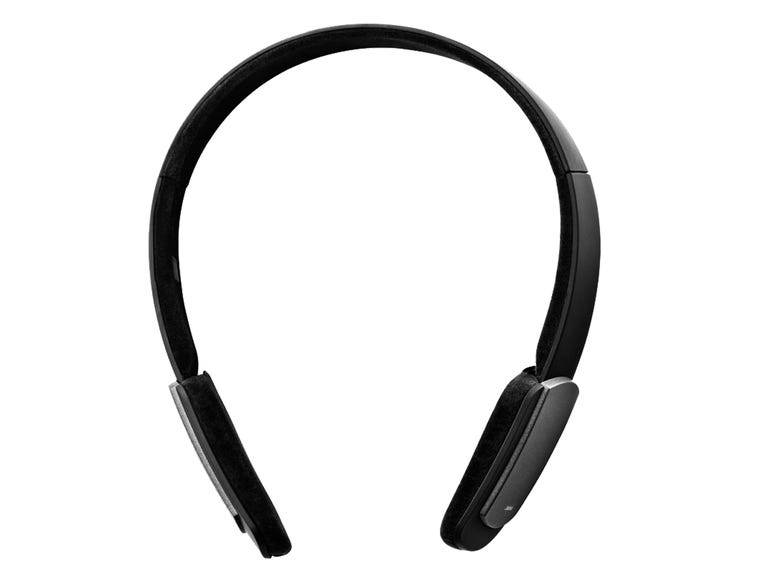 Why You Can Trust CNET
Why You Can Trust CNET Jabra HALO Bluetooth Stereo Headset review: Jabra HALO Bluetooth Stereo Headset
Jabra HALO Bluetooth Stereo Headset
Most cell phones these days come with stereo Bluetooth because even the more basic handsets have some kind of built-in music player. We're happy to see this development, as it lets us listen to music cord-free. Still, stereo Bluetooth headsets generally suffer an image problem of being too dorky-looking. Enter the Jabra Halo, which is so elegant it looks like something you'd see in a high-end electronics store. It also promises to be the first stereo headset with dual-microphone noise canceling. While we appreciate its design, we can't help but be disappointed with it overall. It just does not fit properly over the ears, the touch volume controls are a nuisance, and the call quality is not very good. The Jabra Halo is $129 retail.
The Good
The Bad
The Bottom Line
The Jabra Halo is an over-the-ears-style headset that is unlike most DJ-style headphones. Instead of something bulky, the Halo is slim all the way around, from both ear pads to the connecting headband. The headband and the ear pads are padded in black foam for comfort. There are hinges on either side of the headband so you can fold down the Halo to be more compact. To return it to working position, simply unfold the headphones and snap the headband into place. Folding the Halo shuts it down while snapping it back into its unfolded state turns it on.
Under the right side of the headset is an LED indicator that shows battery life as well as the Bluetooth connection status. On the right ear pad are the multifunction button and a touch-sensor volume control. You slide your finger up and down the side to adjust the volume, and you tap the plus or minus icons a couple of times to skip to the next or previous track. We found the touch-sensor controls to be rather annoying to use. We often would increase and decrease the volume by too much or too little. There should also be a way to shut off the touch mechanism; sometimes we would inadvertently change the volume as we were adjusting the headset. In the end, we would really prefer a physical volume rocker. Underneath the right earpiece is the Micro-USB charging jack.
The two ear pads can be extended on both the left and right side for a more customized fit. However, we felt that even this was not enough to fix the Halo's improper fit issue. The angle of the ear pads are a little off, so that it feels like the ear pads are simply touching our ears when we were expecting a more snug fit. This does depend on the shape and size of your head, so your mileage may vary. Also, the black foam does work to cushion our ears at first, but when worn for hours on end (we wore it for an entire day), we did get some ear fatigue. It's definitely not as comfortable as a big pair of headphones with ear cups, like the Bose QuietComfort 15, for example.
We paired the Jabra Halo with the Apple iPhone 3G and the Samsung Rogue. The pairing process was smooth for both phones. Some phones require a PIN for pairing while others don't; in our case, the iPhone 3G required us to enter a PIN, and the Samsung Rogue did not. The Halo automatically goes into pairing mode the first time it's turned on; to pair it with another device later on, you'll have to press the multifunction button down for a while until the Bluetooth indicator stays a solid blue.
Sound quality for audio playback was OK. Part of this is because of the design of the ear pads--if they were made to mold to our ears a little better, we might have got a bit more richness from the audio. In fact, when we pushed the ear pads to our ears, we did hear better bass. Left as is, though, audio quality was decent but nothing to write home about.
Call quality just did not hold up to Jabra's promises. When we were in a quiet room, it was OK. We heard our callers clearly without a lot of static. Voice quality did seem a bit tinny, but wasn't too horrible. On their end, callers reported quite a bit of echo, and they said our voice sounded quite harsh and machine-like. Still, they could hear us and we could carry on a conversation.
It was a different ballgame when we stepped outside, however. For all the Halo's claims of noise-cancellation, we experienced almost inaudible conversations when we were out on a busy city sidewalk. We heard our callers fine for the most part, but on their end, they could hardly hear us. They reported quite a bit of background noise and said our voice sounded muffled and a little crackly. During one call, they couldn't make out what we were saying at all.
The Jabra Halo's features include the normal answering, ending, and rejecting calls. It also has last-number redial. If your phone or device supports the AVRCP (Audio Video Remote Control Profile) Bluetooth profile, you can also use the headset to control music playback and to advance tracks.
The Halo comes with a USB charger, an AC adapter, a carrying pouch, and a 3.5-millimeter patch cord that connects to the Halo's charger jack in case your phone or music player doesn't have stereo Bluetooth. It has a rated battery life of 8 hours talk time or 8 hours music playback, and 13 days of standby.


